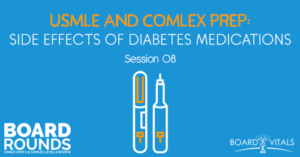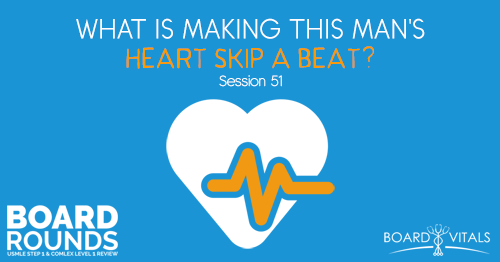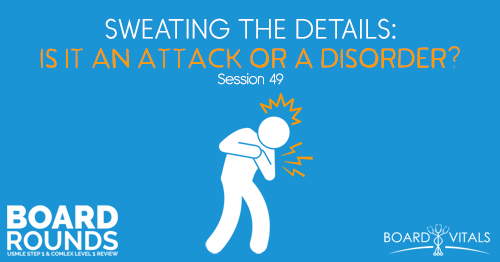Apple Podcasts | Google Podcasts

Session 08
Step 1 and Level 1 love to test the mechanisms or side effects of medications that treat diabetes. Follow along to test your knowledge of diabetic medications and side effects.
Once again, we’re joined by Dr. Andrea Paul, Chief Medical Officer at Board Vitals. Reminder to everyone is that you may know the diagnosis but the question is not going to be that simple. So be prepared for so many different levels of questions and knowledge that you have to know. Use the promo code BOARDROUNDS to save 15% off their QBanks.
[02:00] Diabetes Medications
There are lots of medications for diabetes so it makes it extra complicated and they have their own interesting set of side effects and mechanisms of action that you want to know because they’re commonly tested.
As you’re studying medications, first look at the overarching category. You don’t have to remember every single medication within that overarching category. But in some cases like insulin, it’s helpful to know the different preparation because they may ask about short-acting or long-acting insulin preparation. But generally, other medications have the same mechanisms and side effects so you can combine those together and just remember by the generic names.
Most often, what the test is going to be asking about is mechanism or side effect.
[05:00] Question of the Week
It’s a 56-year-old man with adult-onset diabetes who’s visiting his primary care physician. He’s been on medication while controlled and his glucose levels have improved. But now, he is presenting with his glucose levels trending up over the last 6 months. His A1C trending up and they want to add a second medication. There’s a worrisome side effect of the second medication and it’s asking you to narrow down, looking at the different options of what you could add to what he’s already on. So you need to think about which of those has a worrisome side effect.
He’s on Sulphonylurea and when you think about that category of medications, you start thinking that glucose normally triggers an insulin release from the pancreatic beta cells. They mimic the action of glucose so they close those channels in the cells and that depolarizes them which leads to insulin release.
Then when you think about toxicity, that’s the category of drugs where you think about disulfiram reaction and hypoglycemia.
With insulin, if you take more than what’s necessary, there’s a worrisome side effect of hypoglycemia. Then you start thinking through which of the other categories have something that they would categorize as extremely worrisome. That would knock out things like hypoglycemia because that’s the side effect of almost every antidiabetic medication.
You’d start thinking down the path of severe toxicity and the only medication that has that is the Glitazone category. Those are the medications where their mechanism is they bind receptors that modulate insulin sensitivity. They will increase your insulin sensitivity and decrease gluconeogenesis, increase the number of insulin receptors. They’re known for cardiovascular and hepatotoxicity which is something you have to remember about that category. If you look through all of the other diabetic medication categories, none of them have as worrisome or a severe side effect as that category does.
[08:20] What’s the Worrisome Effect?
In this case, the answer is hepatotoxicity. The way you can narrow it down is knowing that he’s already on a sulphonylurea and they’re adding something that causes a very worrisome side effect. You can immediately narrow it down and find the medication in the list of options that fall into that category.
Choices:
Hypoglycemia
Renal dysfunction
Liver dysfunction
Peripheral neuropathy
Gastrointestinal dysfunction
[09:30] Getting to Your Answer
This is a two-step process where you have to both assume what the next medication to be added is and knowing which category has a worrisome side effect and then coordinating that side effect with the generic name of the medication within that category.
It’s a bit tricky but once you can cross out the other effects then it could lead you down the right path into the category they’re asking for which is the Glitazone category.
There are questions along the same lines where they don’t say what medication was added to the patient and they come in with say, hepatotoxicity and just give you lab values indicating that. So that’s an example of where they may give you a different option of medication and you’d have to identify the one that caused it. So you have to know the side effect as well as recognize the generic name. Not all categories for diabetes medications do have a common ending so there’s some memorization required. But most of them have one or two different endings that you can remember. For instance, sulphonylureas tend to end in -ide or -mide. These are little things that can help you remember what category.
But if you can remember the overarching categories, that will lead you down the right path where your memory might kick in and remember things.
Specifically, the question is looking at adding a second medication and you can already cancel out one with the sulphonylurea. Then look down through the answer options. Just remember what the most severe side effect in each category is and be able to identify which one would be most worrisome or severe.
[12:50] Brand Names
The test doesn’t look at brand names and it’s nice there are these naming conventions. Brand names can be much more challenging to remember compared to generic names which have pretty repetitive patterns. In this case, besides insulin, most sulphonylureas and glitazones will have common endings you can remember.
[13:30] Strategies for Insulin-Specific Questions
Just one thing to note since they like to ask the onset and peak for different types of insulin and just the mechanism. So you should be able to know the mechanism of how insulin works and that cycle in general. Lispro starts to act most rapidly, 15 minutes. Regular insulin is half an hour to an hour. NPH is 1-2 hours and Glargine where the onset is one hour but it actually doesn’t peak. This is something they may ask as well. They tend to follow the same pattern for their peak so the more rapid-acting, Lispro, also peaks first and then the peak extends out later as they go through NPH and Glargine.
They would usually look for the basic pharmacology and pharmacodynamics and kinetics of medication on Step 1. They’d be probably asking something about the onset or peak of different preparations rather than combining them.
Links:
Board Vitals (promo code BOARDROUNDS)
SEARCH SITE
LISTEN FOR FREE











